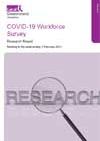This report is part of a series of bi-weekly surveys of all councils in England, Wales and Northern Ireland collecting key workforce data on how the sector is responding to COVID-19.
An online survey is emailed to heads of human resources, or a nominated contact, in councils from England and Wales on the second Wednesday of the month. The data requested relates to the week ending the preceding Friday. The intention is that this collection is the single national source through which such data is gathered, and it will, as appropriate, be shared with government departments and others in addition to providing comparator information for councils.
This report relates to the survey sent out on 10 February 2021 and covers the week ending 5 February 2021. The overall response rate was 55 per cent and covered around a third of the total workforce.
Key findings
- Some 39 per cent of councils reported recruiting additional staff (of any type including casual, agency, contingent, etc) in the week ending 5 February 2021. In total 3,266 additional staff had been recruited in responding authorities: the median number of staff per authority was five and the mean was 45.
- Just under two-thirds of respondent councils (136 respondents) have recorded deaths in service since lockdown. A total of 593 deaths in service were reported by respondents since the start of lockdown (cause not specified).
- Thirty-four per cent of councils reported that they had furloughed at least one member of staff. In total, responding authorities reported there were 9,227 staff furloughed in the week ending 5 February 2021, which was 1.7 per cent of the current workforce, and 48 per cent more than reported in the previous survey.
- The main reason given for furloughing staff was that the service had stopped (61 per cent) or that funding had stopped (37 per cent).
- Some 64 per cent of councils had redeployed staff. In total, in the responding authorities, there were 5,904 staff redeployed in the week ending 5 February 2021, which was one per cent of the current workforce. The median number of staff redeployed was seven and the mean was 35.
- Nearly nine in ten councils (87 per cent) reported that they had at least one member of staff unavailable for work. In total, respondents reported there were 30,621 staff unavailable for work in the week ending 5 February 2021, six per cent of the current workforce. The median number of staff unavailable for work was 60 and the mean was 167.
- Twenty-four per cent of staff were unavailable through ‘self-isolation (other)’ and 47 per cent were unavailable due to ‘non-COVID sickness’.
- When asked whether individual services had enough staff to run them normally or not, the worst affected services were schools and public health: 20 per cent and 15 per cent of single tier and county councils, respectively, reported these services were operating with severe disruption due to staffing numbers. A further 33 per cent of single tier and county councils reported that adult social care services were operating with moderate disruption.
- When asked to assess the council overall, in terms of whether there are enough staff to run services normally or not, 59 per cent reported they were not operating normally.
- Councils were asked about the availability of personal protective equipment (PPE) and COVID-19 testing for staff. Ninety-eight per cent reported they had about the right amount of PPE or more than they need. Eighty-eight per cent said all the staff who need testing can access it.
- Looking ahead, councils were asked if they were experiencing significant difficulties recruiting for some posts or not: 91 (46 per cent) said they were. Councils were subsequently asked to choose from a list of specialist occupations where they were experiencing difficulties: 100 per cent of county councils were having difficulties recruiting children’s social workers
-
In district councils, 58 per cent of those that responded to the question said they were having problems recruiting planning officers and 50 per cent said they were having problems recruiting environmental health officers.
- Councils were asked to choose the five occupations or roles where recruitment difficulties were most acute. Again, all respondent county councils reported that they had acute difficulties recruiting children’s social workers.
- Out of the councils who had said they had acute difficulties in recruiting children’s social workers, 55 per cent said they had both difficulty recruiting generally and difficulty recruiting the required expertise, experience or qualification.
- Councils were asked if they are likely to recruit additional staff specifically to COVID-19 and/or the EU transition or not: 41 per cent said they were likely recruit additional staff in response to COVID-19, 30 per cent said they were not likely to recruit additional staff at all and 26 per cent said they did not know.
- Councils were asked to look ahead and think about staff and what they were considering doing in this current financial year and in the next one (2021/22). Out of the councils that answered this question, 61 per cent said they were thinking of making no substantive changes within this financial year, and 54 per cent said they were not thinking it for 2021/22. Fifteen per cent of those that answered this question said that they were thinking of reducing staff numbers overall in 2020/21, and 25 per cent said they were thinking to do this in 2021/22.
- Councils were asked to think about the COVID-19 vaccination and whether they thought that the staff who need the vaccine had received it or not: 49 per cent reported that all or most staff who need the vaccine had received it.
To view an accessible version of this document, please email [email protected].

- Published by:
-
LGA
- Reference code:
